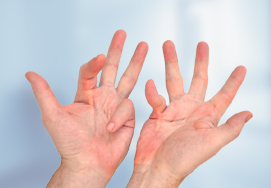Arteriovenous Fistulas
when kidneys function at only below 10 to 15 percent of their normal capacity, they cannot effectively do their job, such as remove waste or excess fluid from your blood. Arteriovenous fistula for hemodialysis provides good blood flow for many years.

- What is an Arteriovenous fistula Created
- Why is arteriovenous fistula a gold standard ?
- Caring for a fistula
- Good needle techniques to avoid injuring fistula ?
What is an Arteriovenous fistula Created
An AV fistula is created by directly connecting a person’s artery and vein—usually in the arm. This procedure may be performed as an outpatient operation using a local anesthetic.
As blood flows to the vein from the newly connected artery, the vein grows bigger and stronger. The patient is taught to do exercises—such as squeezing a rubber ball—to help the fistula mature for use. This takes six weeks to four months.
Once the fistula has matured, it can provide good blood flow for many years of hemodialysis.
Why is arteriovenous fistula a gold standard ?
The National Kidney Foundation (NKF), Centers for Medicare and Medicaid Services (CMS) and Dialysis Patient Citizens (DPC) agree fistulas are the best type of vascular access.
A fistula is the “gold standard” because:
- It has a lower risk of infection
- It has a lower tendency to clot
- It allows for greater blood flow and reduces treatment time
- It stays functional longer than other access types
- It’s usually less expensive to maintain
Caring for a fistula
Here are things you can do to take care of your access.
Cleanliness – Keep your access area clean and free of any trauma. Your dialysis care team will teach you how to carefully wash it before each treatment. Look for signs of infection,including pain, tenderness, swelling or redness around your access area. Also, be aware of any fever and flu-like symptoms. If you do get an infection and catch it early, it can usually be treated with antibiotics.
Unrestricted blood flow
Any restriction of blood flow in the fistula can cause clotting. Here are some tips to help avoid restriction
- avoiding tight clothes, jewellery or anything that puts pressure on your access
- Don’t carry heavy items over your access area.
- Have your blood pressure taken and blood drawn from your non-access arm.
- Don’t sleep with your access arm under your head or pillow.
- Check the pulse in your access daily:
The vibration of blood going through your arm is called the “thrill,” which you should check several times a day. If the “thrill” changes or stops, a blood clot may have formed
Good needle techniques to avoid injuring fistula ?
The ladder and buttonhole techniques are strategies for using a needle on a fistula, according to the National Institute of Diabetes and Digestive and Kidney Diseases (NIDDK).
The ladder technique requires you or your dialysis care provider “stick” the fistula vertically in a different place every time. This is called “climbing,” and it saves you from weakening a certain area by repeatedly sticking it.
With the buttonhole technique, needle sticks are limited to a single site that is used repeatedly and allows for fewer traumas














